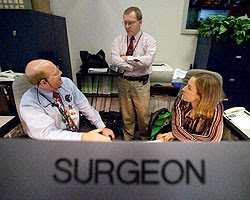Longtime reader Lisleman of A Few Clowns Short asks:
"I was wondering about health issues. Would you say that astronauts are the most monitored humans around? Do they monitor them constantly while in the ISS? Lastly, have the doctors ever prevented some illness because they noticed a warning in the monitored levels of an astronaut?"
I had a wild guess that individuals in prison might be the "most monitored", but this is an interesting avenue, both medically and operationally. I had some inklings, but called upon some friends in Mission Control to point me in the right direction.
NASA physiologist Liz Warren @Spasmunkey (also featured in my Workers At NASA section) says:
Prior to an ISS flight, I'd have to agree astronauts are some of the most medically monitored people on the planet. Millions of dollars are invested in each astronaut during training, and we ensure they don't become ill and jeopardize the mission.
During flight, astronauts have weekly meetings with their flight surgeons and psychiatrists. In terms of medical monitoring IN-FLIGHT, there actually isn't much. Exercise is monitored via a heart rate monitor. There is a portable blood analyzer on-orbit for routine analysis. Blood and urine samples gathered for research are frozen and analyzed on the ground after the crewmember goes home.
I am not aware (due to medical privacy) of any medical intervention that prevented someone from getting sick on-orbit. However, one Russian mission was aborted prematurely due to a crewmember developing a medical issue in-flight.

Dr. Jennifer Law, Flight-Surgeon, says:
I can think of intensive care unit patients that are more closely monitored with invasive blood pressure monitors, heart rate monitors, temperature probes, and so on. Astronauts don't get this kind of medical scrutiny when they're on orbit. Prisoners may be monitored all the time in terms of their location and activity, but I don't think anyone keeps track of their vital signs and other physiological parameters.
Modern astronauts aren't monitored all the time like astronauts in the early space days were, and don't wear electrodes 24/7. They get routine physicals and are monitored during activities like exercise, EVA, and certain experiments, but the rest of the time they are not monitored per se, though like Liz said they do chat with their crew surgeon regularly so that any budding issues are addressed early.
As for medical interventions that prevent astronauts from getting sick on-orbit, we tend to focus on what we call primary prevention, e.g., astronaut selection, health maintenance, crew quarantine prior to flight, and regular exams. The irony is that when we do our jobs right, none of the astronauts get sick and we have nothing to show for it! Though I do know arrhythmias have been noted in space.
Flight Controller Mike Allyn @FTCMike says:
Jen brings up a good point as to context of the word "monitored". I jumped to medical because of the question about preventing illness, but I can speak to monitoring the crew on a non-medical basis. Through various means of telemetry monitoring, MCC can often extrapolate what the crew is up to. Power draw always increases in the Service module when the crew starts turning on lights. We can also tell if there are crewmembers awake from the control torques on the vehicle. Rate measurements are so accurate coming from the US Rate Gyro Assemblies (RGA's) and the Russian Givus that the commands to control the torque of the Control Moment Gyro's (CMG's) react slightly to the crew bouncing off the walls.
We protect the crew's sleep and off duty time as much as we can. Being able to tell when they are awake is useful for when we need to speak to them at the earliest convenience, but perhaps not worth waking them. Another way to tell if a crew member is up and moving is by smoke detector scatter measurements. Anytime there is a tiny bit of dust detected by the many smoke detectors, they register increased scatter. One way this increases is by crewmembers working and moving in close proximity to them, which increases airflow and kicks up dust.
So there you have it, Lisleman! Hope that answers all your questions -- and very special thanks to our friendly neighborhood NASA MCC heroes for their time and expertise!




































































